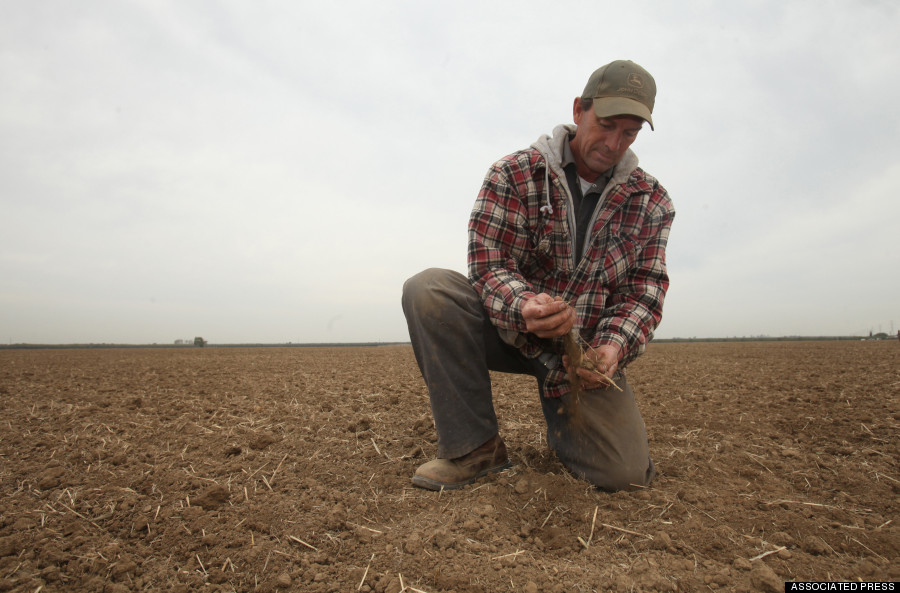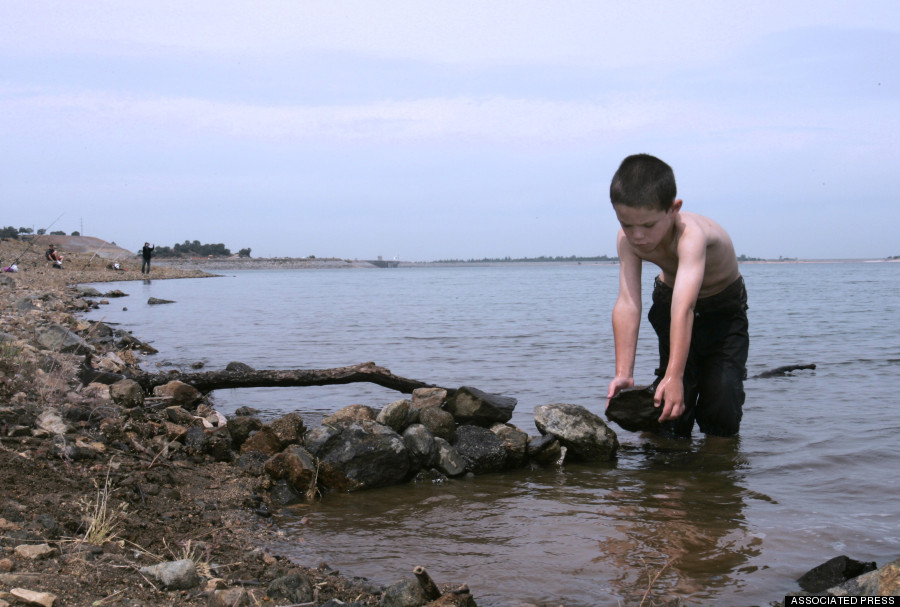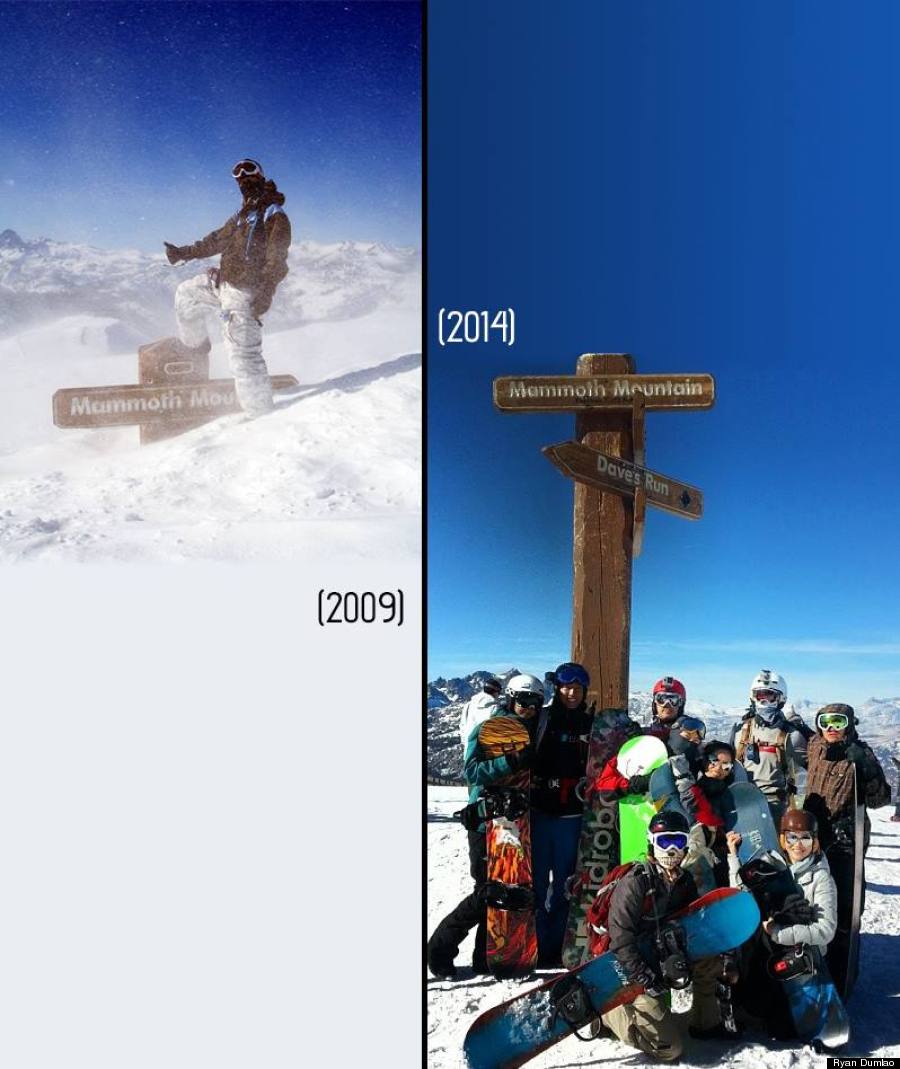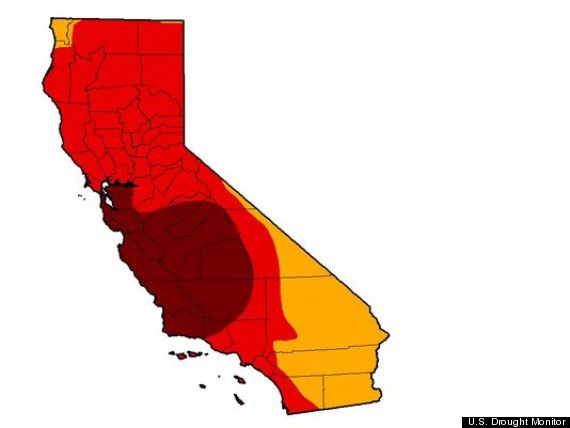California May Have Hit Its Driest Point In 500 Years, And The Effects Are Frightening
California is dry as a bone, and the effects are like something out of an apocalyptic film.
Cities are running out of water. Communities are fighting over what little water there is. Local governments are imposing rationing coupled with steep fines. Fires are ravaging the state. Entire species and industries are threatened.
For California, 2013 was the driest year since the state started measuring rainfall in 1849. Paleoclimatologist B. Lynn Ingram says that, according to the width of old tree rings, California hasn’t been this dry for about 500 years.
Gov. Jerry Brown has declared an emergency, President Barack Obama has pledged his support, and state and federal officials are stepping in to protect the state's most vulnerable groups. Californians of various faiths have taken to holding prayer sessions, looking to the heavens for rain. Here are some of the drought's effects so far.
Running Out Of Drinking Water

Seventeen rural communities in California are in danger of running out of water within 60 to 120 days, according to a list compiled by state officials. As the drought goes on, more communities are likely to be added to the list.
With only about seven inches of rain in California in 2013 -- far below the average of 22 inches -- wells are running dry and many reservoirs are about 30 percent full (including Folsom Lake, shown above).
The Sierra snowpack, where California gets about a third of its water, was 88 percent below average as of Jan. 30. Some are concerned that the diminished snowmelt is causing more pumping of contaminated groundwater, particularly in disadvantaged areas such as California's San Joaquin Valley.
Food Supply Threatened

California's $45 billion agriculture business accounts for 15 percent of U.S. crop sales. But this year, farmers fear they may lose their entire crops. That could cause food prices to go up for most Americans. Some farmers are paying the expensive price of scarce water to irrigate crops. Others, unable to afford water, have been forced to leave fields fallow.
Ranchers are struggling to feed livestock, as there is much less grass. Some have been paying more for alternative feed. Others have had to sell portions of their herd. In California's vineyard capital, Napa Valley, wine grape growers said some vines are ripening early. Farmers are planning fewer crops to save water.
Fires Of Unprecedented Number And Size

Drought and a warming climate has left California particularly vulnerable to wildfires. From Jan. 1 to Jan. 25, state firefighters responded to 406 wildfires. During the same period last January, there were none, and the historic average is 69.
The Colby fire in the LA-area earlier this month is evidence of the danger. The fire spread rapidly and charred five homes, 17 other structures and about three square miles of land.
In August, the Rim Fire (pictured above) ravaged Yosemite National Park, leaving a barren moonscape that researchers say is larger than any burned area since the Little Ice Age, which began in 1350.
Conflict Over What Little Water There Is

California's water wars between Los Angeles and farmers in eastern California were famously depicted in the 1974 film "Chinatown." Nearly a century after the initial conflict, the water wars are not over.
For years, signs along Central California fields reading "Congress-created dustbowl" and "man-made drought" have reflected an ongoing battle between farmers and environmentalists over water from a large estuary northeast of the San Francisco Bay called the Sacramento-San Joaquin Delta. Three million acres of farmland and 25 million people from San Jose to San Diego depend on water from the delta, but environmental regulations to protect threatened delta smelt and endangered salmon have restricted the amount of water that can be pumped from it.
With the drought in full force, House Speaker John Boehner (R-Ohio) and three Republican congressmen from Central California proposed emergency drought legislation to allow farmers to pump irrigation water from the protected delta. Their effort was unsuccessful, but they have vowed to try again. In addition, the governor, in conjunction with state agencies, has proposed a plan that would cost from $25 billion to as much as $67 billion to build two 30-mile underground tunnels to ensure water delivery from Northern California to Southern California.
Environmentalists vehemently oppose both propositions, arguing they will destroy the delta's ecosystem. Instead, they say governments should legislate efforts to capture more rain and conserve and recycle water (which Brown hasn't mandated, but is encouraging).
While farmers fight to water their land and environmentalists fight to protect ecosystems, social activists are advocating for disadvantaged communities in parts of the state where low-income minorities have poor quality drinking water. Furthermore, as farmers and ranchers cut back, their employees, who are predominantly Latino, lose jobs.
Water Rations And Steep Fines

Brown has called for a 20 percent voluntary reduction in water use for all Californians "in both rural areas and cities." But more and more cities are mandating it, particularly in Northern California.
Sacramento and Folsom have mandated a 20 percent reduction for all residents and businesses. Sacramento has stepped up enforcement of restrictions on watering lawns by time of day and day of week, with fines up to $1,000.
Santa Cruz has banned restaurants from providing customers with drinking water unless it is requested and has forbidden the filling of newly installed swimming pools. Willits, a town of 5,000 in Mendocino County, has adopted rationing that limits a family of four to 150 gallons of water a day and bans outdoor watering and hosing down pavement. Marin County has asked residents to not clean their cars or to do so only at eco-friendly car washes. Other counties have imposed similar restrictions.
Parks, Species And Tourism Threatened

California has a large ski industry, but this year, there's hardly any snow. Nearly all the snow at major resorts in Lake Tahoe, Mammoth and other parts of the Sierra Nevada mountains this month was made with expensive snow-making machines. If it wasn't for the machines, which require a lot of water and compressed air, the resorts would probably have to close. Many small, family-owned resorts have already shut. Yosemite National Park, which normally attracts skiers this time of year, is offering summer-like hikes and horseback riding instead.
California wildlife officials have banned fishing in several rivers, including the San Lorenzo River, the Big Sur River and the Pescadero Creek, to protect salmon and steelhead trout. The fish are in danger as low water levels in many rivers may prevent them from migrating and spawning. In cities and towns surrounding the Sierra Nevadas, there have been increased sightings of bears, possibly because the drought cuts down on bears' food sources.
In Southern California, the iconic Joshua Trees of Joshua Tree National Park recently produced larger flowers than residents have ever seen, possibly because of a biological urge to produce more seeds to survive with less rain. While the huge blooms were beautiful, they're a sign that the trees, which have been in decline, are struggling to survive.
Scientists project that extremely dry conditions will continue in the future due to climate change. Researchers later this year will examine how much of this recent California drought can be blamed on human-caused climate change.
Source
http://www.huffingtonpost.com/2014/01/30/california-drought-effects...
Comment
-
Comment by Derrick Johnson on August 18, 2014 at 8:22am
-
California Drought Holds Steady Amid Summer Storms, Experts Say
By Shawn Hubler
SACRAMENTO, Calif., Aug 14 (Reuters) - As California lawmakers moved a nearly $7.6 billion water bond to the November ballot, federal meteorologists said on Thursday that the state's ongoing drought has appeared to level off, though conditions remain "extreme" in 80 percent of the state.
"Areas of dryness and drought remained unchanged," according to the National Drought Mitigation Center, based at the University of Nebraska, despite epic storms that have intermittently lashed parts of both Northern and Southern California.
Torrential rains early this month triggered lethal mudslides and flash floods in the San Gabriel Mountains near Los Angeles, and thunderstorms both eased and complicated the work of firefighters battling wildfires this week in Northern California.
But those storms "were pretty much a drop in the bucket," said Richard Tinker, a drought expert with the federal government's Climate Prediction Center.
"Any rain this time of year - while a bonus - doesn't really have much of an effect on the drought," Tinker said.
Nearly 82 percent of the state is experiencing "extreme" drought, according to the latest U.S. Drought Monitor map, which is updated weekly by the center. Fifty-eight percent of the state, meanwhile, is withering under "exceptional" drought, which is the most severe measure on the center's scale.
The figures, while sobering, indicated a pause in what had been a seemingly inexorable expansion of the drought across the nation's most populous state and most important agricultural producer. The percentage of the state gripped by the drought has been relatively unchanged for the past couple of weeks.
Tinker added that the state's major reservoirs in aggregate were at 59 percent of the historical average-low, but not as low as the 41 percent recorded during the 1976-77 drought.
Only a handful of smaller Central Coast dams, he said, had fallen below those 1977 levels, a situation that lawmakers are seeking to address with the water bond proposed for the upcoming ballot.
Made more urgent as the drought has strained California's water supply to crisis proportions, funds raised by selling bonds would shore up the state'
s water infrastructure, underwriting projects that include improved water storage, flood control, groundwater cleanup, drinking and wastewater treatment and investments to address climate change. (Editing by Sharon Bernstein and Sandra Maler)Source: http://www.huffingtonpost.com/2014/08/15/california-drought_n_56799...
-
Comment by Derrick Johnson on May 17, 2014 at 9:12am
-
The California Drought Is Far From Over, And The Entire State Is Suffering
For a few days last month, it rained in San Francisco. Residents across the city cheered a welcomed respite from a drought that has crippled California for more than two years -- but the celebration turned out to be premature.
On Thursday, for the first time this century, the U.S. Drought Monitor declared that all of California is in a “severe” drought, with many areas of the state in an even worse condition, from "extreme" to "exceptional," the poorest possible rating.
“This is a once-in-a-generation conversation,” Mark Svoboda, a climatologist at the National Drought Mitigation Center, told The Huffington Post. He added that the last time California experienced comparable conditions was in the mid-1970s.
“The state has doubled its population between then and now,” Svoboda said. “You’ve got a lot more people using a relatively finite amount of water.”
The map below, courtesy of the U.S. Drought Monitor, shows the varying levels of drought throughout California. The orange represents “severe,” the red is “extreme,” and the maroon is “exceptional” -- the agency’s highest level (Story continues below):

No area of the state is feeling the effects of the drought more harshly than San Diego, where wildfires have ripped through more than 10,000 acres of land and tens of thousands of residents have been forced to evacuate. “In a drought, the biggest threat to health and human safety is wildfire,” Doug Carlson, an information officer at the California Department of Water Resources, told HuffPost.
And there doesn’t appear to be an end in sight. “The drought has set the stage for a very busy, very long, potentially very dangerous fire season,” Daniel Berlant, a spokesperson for CAL FIRE, said to HuffPost. “As we move into the more traditional summer months, the days are only going to get longer, and the temperatures are only going to get higher.”
California’s wildfire season usually peaks during summer and fall months and then tapers during the typically rainy winter. But the drought has turned wildfires into a year-round issue. “With that lack of rain, the grass, brush and trees really have been tinder-dry all year long,” Berlant explained, noting such conditions help flames flourish.
Svoboda added that the state’s hot, dry surface leads to a hot, dry, atmosphere, which creates a prime environment for wildfires to spread. “You also typically see windier conditions,” he added. “These are all things that fires feed on.”
The damage in Southern California has ravaged hills, homes and businesses. Beloved craft brewery Stone Brewing Company evacuated its premises on Thursday. On Wednesday, KTLA senior producer Marcus Smith tweeted a widely-recirculated photo of a “firenado,” a dangerous phenomenon caused by strong winds whipping spirals of fire into the air.
Authorities have deployed more than 2,500 firefighters into the area, but Svoboda noted that for wildfires of this scale, manpower isn’t the solution. “You can’t have human resources put it out,” he said. “You need a rainstorm.”
Raging wildfires aren’t the only consequence of California’s dry conditions. Reservoirs have drained, and many communities are being forced to ration their water supplies. Moreover, experts predict the drought will drastically impact both the state and the nation’s food supply.
“California produces nearly 50 percent of the nation’s fruits, vegetables, and nuts -- they’re kind of the nation’s garden,” Denise Gutzmer, a drought impact specialist at National Drought Mitigation Center, told HuffPost. “We’re going to be seeing higher produce prices in the store this summer.”
Nearly 1 million acres of agricultural land will likely be affected. An Arizona State University study released last month found that, as a result, lettuce prices may spike by as much as 34 percent, and tomato prices by some 18 percent. And with less land to maintain, as many as 20,000 farm workers could find themselves unemployed.
Moreover, local food banks that rely on California produce to feed their customers will likely see a sharp drop in donations, and will subsequently be forced to spend more money importing out-of-state produce. Sue Sigler, the head of the California Association of Food Banks, told the San Francisco Chronicle it was a “perfect storm of drought-related factors.”

Two men look out towards the water on the dry bed of the Stevens Creek Reservoir.
In February, when California Gov. Jerry Brown (D) declared a state of emergency due to the drought, he urged residents to cut their water usage by at least 20 percent. As a result, communities across the state have adopted a variety of unique measures.
City governments have banned washing cars with hoses, fined homeowners who don’t promptly fix leaks and handed down strict landscape watering schedules. Enforcement of these new laws is perhaps most evident in Sacramento, where 40 city employees have been re-designated as “water cops” tasked with reporting and responding to wasteful maintenance.
The new rules have been a wake-up call for residents with sprawling lawns. In the grassy Golf Course Terrace Estates of Sacramento, the neighborhood is starting to take on a different look.
“A number of neighbors have seized this as an opportunity to redo their landscape that’s quite old, and they’ve taken out the grass and plants that require a lot of water and are putting in various things,” said neighborhood association spokesman Ernest Lehr, who has lived in the area for 50 years. “One fellow put in a fabulous bocce ball court in front.”
Sometimes, investing in such changes pays off. Sacramento launched a “Cash for Grass” pilot program in March that will dole out $100,000 to residents who replace their lawns with drought-resistant or native plants. The Metropolitan Water District of Southern California has offered residents a similar deal.
“This is an opportunity to do something, to rethink and to learn, especially for folks who have moved here from other areas and regions,” Lehr told HuffPost. “Maybe they’re not that familiar with shrubs, plants and trees that are really best suited for this kind of a climate.”
While experts remain unsure what prompted such severe conditions, a Utah State University study released in April directly linked the situation to climate change. “Increased greenhouse gases since the 1970s are a major contributor to California's drought,” co-author Simon Wang told HuffPost.
Climatologists predict that the coming of El Niño may mitigate some of the drought’s harshest effects later this year. In the meantime, drought specialists urge residents to continue to be mindful.
“Do your best to conserve, and have hope that the rains next winter will be better,” said Gutzmer, the drought impact specialist. “If El Niño pans out, they could have a nice winter next year.”
Source: http://www.huffingtonpost.com/2014/05/16/california-drought_n_53405...
-
Comment by Mark on February 28, 2014 at 10:36am
-
More before and after pictures
http://www.dailymail.co.uk/news/article-2569919/Shocking-pictures-C...
-
Comment by Derrick Johnson on February 1, 2014 at 8:22am
-
California Drought Prompts Unprecedented Water Conservation Efforts
SACRAMENTO, Calif. (AP) — Amid severe drought conditions, California officials announced Friday they won't send any water from the state's vast reservoir system to local agencies beginning this spring, an unprecedented move that affects drinking water supplies for 25 million people and irrigation for 1 million acres of farmland.
The announcement marks the first time in the 54-year history of the State Water Project that such an action has been taken, but it does not mean that every farm field will turn to dust and every city tap will run dry.
The 29 agencies that draw from the state's water-delivery system have other sources, although those also have been hard-hit by the drought.
Many farmers in California's Central Valley, one of the most productive agricultural regions in the country, also draw water from a separate system of federally run reservoirs and canals, but that system also will deliver just a fraction of its normal water allotment this year.
The announcement affects water deliveries planned to begin this spring, and the allotment could increase if weather patterns change and send more storms into the state.
Nevertheless, Friday's announcement puts an exclamation point on California's water shortage, which has been building during three years of below-normal rain and snow.
"This is the most serious drought we've faced in modern times," said Felicia Marcus, chairwoman of the State Water Resources Control Board. "We need to conserve what little we have to use later in the year, or even in future years."
State Department of Water Resources Director Mark Cowin said there simply is not enough water in the system to meet the needs of farmers, cities and the conservation efforts that are intended to save dwindling populations of salmon and other fish throughout Northern California.
For perspective, California would have to experience heavy rain and snowfall every other day from now until May to get the state back to its average annual precipitation totals, according to the Department of Water Resources.
"These actions will protect us all in the long run," Cowin said during a news conference that included numerous state and federal officials, including those from wildlife and agricultural agencies.
Friday's announcement came after Gov. Jerry Brown's official drought declaration in mid-January, a decision that cleared the way for state and federal agencies to coordinate efforts to preserve water and send it where it is needed most. The governor urged Californians to reduce their water use by 20 percent.
It also reflects the severity of the dry conditions in the nation's most populous state. Officials say 2013 was the state's driest calendar year since records started being kept, and this year is heading in the same direction.
A snow survey on Thursday in the Sierra Nevada, one of the state's key water sources, found the water content in the meager snowpack is just 12 percent of normal. Reservoirs are lower than they were at the same time in 1977, which is one of the two previous driest water years on record.
State officials say 17 rural communities are in danger of a severe water shortage within four months. Wells are running dry or reservoirs are nearly empty in some communities. Others have long-running problems that predate the drought.
The timing for of Friday's historic announcement was important: State water officials typically announce they are raising the water allotment on Feb. 1, but this year's winter has been so dry they wanted to ensure they could keep the remaining water behind the dams. The announcement also will give farmers more time to determine what crops they will plant this year and in what quantities.
Farmers and ranchers throughout the state already have felt the drought's impact, tearing out orchards, fallowing fields and trucking in alfalfa to feed cattle on withered range land.
Without deliveries of surface water, farmers and other water users often turn to pumping from underground aquifers. The state has no role in regulating such pumping.
"A zero allocation is catastrophic and woefully inadequate for Kern County residents, farms and businesses," Ted Page, president the Kern County Water Agency's board, said in a statement. "While many areas of the county will continue to rely on ground water to make up at least part of the difference, some areas have exhausted their supply."
Groundwater levels already have been stressed, after pumping accelerated during the dry winter in 2008 and 2009.
"The challenge is that in last drought we drew down groundwater resources and never allowed them to recover," said Heather Cooley, water program co-director for the Pacific Institute, a water policy think tank in Oakland. "We're seeing long term, ongoing declining groundwater levels, and that's a major problem."
Many towns and cities already have ordered severe cutbacks in water use.
With some rivers reduced to a trickle, fish populations also are being affected. Eggs in salmon-spawning beds of the American River near Sacramento were sacrificed after upstream releases from Folsom Dam were severely cut back.
The drought is highlighting the traditional tensions between groups that claim the state's limited water for their own priorities — farmers, city residents and conservationists.
Chuck Bonham, director of the California Department of Fish and Wildlife, urged everyone to come together during the crisis.
"This is not about picking between delta smelt and long-fin smelt and chinook salmon, and it's not about picking between fish and farms or people and the environment," he said. "It is about really hard decisions on a real-time basis where we may have to accept some impact now to avoid much greater impact later."
http://www.huffingtonpost.com/2014/01/31/california-drought-reserv_...
SEARCH PS Ning or Zetatalk
Nancy Lieder, Emissary of the Zetas.
https://poleshift.ning.com/xn/detail/3863141:Comment:1168188
Awakening to the Alien Presence ZetaTalk
The truth will likely never to be known to the public but be washed away in the Nibiru panic soon to engulf the world.
The Worst of the Cover-Up
https://poleshift.ning.com/profiles/blogs/the-worst-of-the-cover-up
Main Establishment Lies
https://poleshift.ning.com/profiles/blogs/main-establishment-lies
Donate
© 2025 Created by 0nin2migqvl32.
Powered by
![]()
You need to be a member of Earth Changes and the Pole Shift to add comments!
Join Earth Changes and the Pole Shift